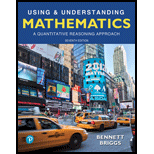
Concept explainers
Toxic Dumping in Acidified Lakes. Consider a situation in which acid rain has heavily polluted a lake to a level of pH 4. An unscrupulous chemical company dumps some acid in to the lake illegally Assume that the lake contains 100 million gallons of water and that the company dumps 100,000 gallons of acid with pH 2.

a.What is the hydrogen ion concentration, [H+], of the lake polluted by acid rain alone?
b.Suppose that the unpolluted lake, without acid rain, would have pH 7. If the lake were then polluted by company acid alone (no acid rain), what hydrogen ion concentration, [H+], and pH would it have?
c. What is the hydrogen ion concentration, [H'], after the company dumps the acid into the acid rain-polluted lake (pH 4)? What is the new pH of the lake?
d. If the U.S. Environmental Protection Agency can test for changes in pH of only 0.1 or greater, could the company’s pollution be detected?
Want to see the full answer?
Check out a sample textbook solution
Chapter 8 Solutions
Pearson eText for Using & Understanding Mathematics: A Quantitative Reasoning Approach -- Instant Access (Pearson+)
- Please refer belowarrow_forwardMatlab Do question #3 from Section 1.10 Exercises of the textbook (theproblem about Mac and Cheese). For each part, be sure to explicitly give the appropriate system ofequations (as a comment) before entering the appropriate matrices into MATLAB. Show all of yournecessary MATLAB computations.arrow_forwardPLEASE ANSWER ALL PARTSarrow_forward
- PLEASE ANSWER BOTH PARTSarrow_forward(1) (16 points) Let f(x, y) = 2x + 3y + In(xy) (a) (6 points) Calculate the gradient field Vf(x, y) and determine all points (x, y) where ▼f(x, y) = (0, 0). (b) (4 points) Calculate the second derivative matrix D²f(x,y).arrow_forwardLet f(x, y) = 2x + 3y+ In(xy)arrow_forward
- (3) (16 points) Let D = [0, π/2] × [0, 7/6]. Define T: DCR2 R3 by → T(0, 4) = (2 sin cos 0, 2 sin sin 0, 2 cos x). Let S be the surface parametrized by T. (a) (8 points) Determine the normal, call it n(p), for the tangent plane TS at an arbitrary point p = T(0, 4). (b) (4 points) Show that n(p) parallel to the position vector T(0, 4) determined by p? Do the two vectors have the same direction or opposite direction? Explain. (c) (4 points) At which points p, if any, is TS parallel to the xy-plane?arrow_forward5:19 0 TEMU TEMU >>> 49 95% University at Albany - Single Sig... L Lumen OHM D2L HW4- AMAT100-Precal HW4 Score: 12.99/21 Answered: 18/21 × Question 16 Score on last try: 0 of 1 pts. See Details for more. > Next question Get a similar question You can retry this question below Find the inverse for the function k(x) = √√7x+12 k-¹(x) = Question Help: Video Message instructor Submit Question esc ||| F1 80 ୮ (x) = tarrow_forwarduse components when solvingarrow_forward
- File Edit View History Bookmarks Profiles Tab Window Window Help Things Quadratics! Part 1 X SM◄))) 61% Fri 25 student.desmos.com/activitybuilder/instance/67b739e7356cae7898fd0dbd/student/67b8f115811d42186c239e23#screenid=41a95 ngs Quadratics! Part 1: Parabolas Mitchell 30 30 foo feet 20- 20 10 0 -10 FEB 21 3 10 10 80 FS F3 X Intercepts #2 20 20 Approximately how tall is the shooter? > Which intercept did you use to solve the above problem? x-intercept y-intercept 30 feet Explain your thinking. 1 √E Submit 00000 acBook stv 399 ? DOD 000 F4 % 5 W E R F5 A F6 F7 F9 & * 7 8 9 0 Y U C 014arrow_forwardMatlab. Add written awnsers (denoted by stars) in comments.arrow_forwardmin(sin x, cos x) 2πT 0 max (esin x, ecos x dxarrow_forward
- Algebra & Trigonometry with Analytic GeometryAlgebraISBN:9781133382119Author:SwokowskiPublisher:Cengage
